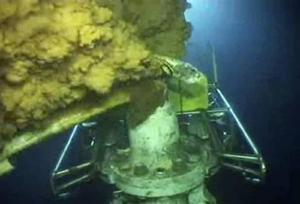Gulf of Mexico oil spillBP's oil spill depleting oxygen in Gulf, decimating Gulf's abundant sea life
The magnitude of the BP oil spill disaster becomes clearer; scientists confirm the massive oil spill spread more than forty nautical miles from the disaster site and at a depth of 3,300 feet; scientists have said that in addition to being nearly impossible to clean up, the oil plumes could deplete oxygen in the Gulf, decimating its abundant sea life

Crude oil streaming from the Deepwater Horizon wellhead // Source: heatingoil.com
Scientists have confirmed the spread of oil from the massive Gulf of Mexico spill more than forty nautical miles from the disaster site and at a depth of 3,300 feet, a top U.S. official said Tuesday.
The scientific analysis by the National Oceanic and Atmospheric Administration (NOAA) appeared to confirm fears that massive “plumes” of oil are suspended in the Gulf waters, greatly complicating any hope of cleaning up the spill.
NOAA’s research offers proof that vast quantities of oil have spread not just along the ocean’s surface, but at a great depth underwater. “NOAA is confirming the presence of very low concentrations of subsurface oil at sampling depths ranging from the surface to 3,300 feet at locations 40 to 42 nautical miles northeast of the well site,” agency head Jane Lubchenco, told a news conference.
AFP reports that scientists have said that in addition to being nearly impossible to clean up, the oil plumes could deplete oxygen in the Gulf, decimating its abundant sea life.
Meanwhile, Admiral Thad Allen, commander of the U.S. Coast Guard and the top U.S. official overseeing the spill cleanup and containment effort, said Tuesday that he has instructed the U.S. Geological Survey (USGS) take a new look at the ruptured pipeline and to give him a new estimate of how much oil may actually be pouring out of it, especially after the riser pipe was trimmed last week.
BP trimmed the riser so that it could be outfitted with a so-called lower marine riser package (LMRP) to collect and transport oil and gas flowing from the well. Some experts, however, expressed concern that the maneuver could actually have the effect of increasing the amount of crude spewing from the ruptured pipe.
Allen said he has asked the USGS to confirm whether this is the case. “They are going to go back and refine the assumptions on the original flow rate, and then give us their best estimate on the impact of the cut of the riser pipe,” Allen said at Tuesday’s briefing.
Lubchenco at the same press conference said scientists have completed a process of “fingerprinting” the oil to confirm that it did in fact, come from the BP spill. “The test results confirm that there is oil subsurface. We’ve always suspected that, but it’s good to have confirmation,” the NOAA chief said.
She said scientists working with NOAA are trying to assemble “a three-dimensional puzzle, so that we can have a better sense of what’s where, in what amounts, and what impact it’s having,” Lubchenco said.
The analysis, which she said is being carried out by NOAA in concert with experts at the University of South Florida, rules out that the oil could have come from any source other than the BP spill.
“We’ve been tracking where the oil is going at the surface and where it is going below the surface,” Lubchenco said, calling the BP oil spill is “a human tragedy and an environmental disaster.”
She added however that some oil found 142 miles southeast of the well site had been found in tests to be “not consistent” with the BP oil, explaining some oil was naturally occurring in the Gulf.
Lubchenco said the work to determine just how far the BP oil is spreading is ongoing, and that other ships have been sent out in the Gulf to take new water samples.
“Those are in the lab being analyzed now,” she said. “We will report on those as soon as we can.”
Millions of gallons of crude have poured in the Gulf of Mexico since the April 20 explosion on the BP-operated Deepwater Horizon rig, lying just off the Louisiana coast.
